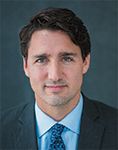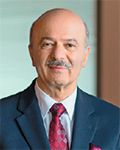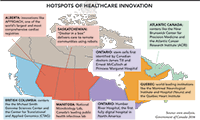Country Report: Canada
Despite having the tenth-largest pharma market in the world and being the birthplace of medical breakthroughs, from insulin to stem cells, Canada seems to be punching below its weight when it comes to health innovation. There are signs, however, that things may be changing as the nation looks to bulk back up.
This sponsored supplement was produced by Focus Reports
Project Director: Lisa Diericks
Project Coordinator: Karen Xi
Project Assistant: Luca Nardini, Carole-Anne Bruneau
Project Publisher: Mariuca Georgescu
Senior Editor: Louis Haynes
Editor: Patrick Burton
Graphic Assistance: Miriam Léon
Cover photo © Flickr: Guillaume Blum
For exclusive interviews and more info, please log onto www.pharmaboardroom.com or write to contact@focusreports.net
Canada celebrates 150 years of independence in 2017 as one of the most prosperous, diverse and stable countries on earth. With one of the highest GDPs per capita in the world at USD 42,158, Canada is also expected to lead the G7 in terms of economic growth in 2017. However, contradictions abound in the country's healthcare and life sciences landscape: the country benefi ts from a universal healthcare system but lacks universal drug coverage, resulting in Canadians having one of the highest out-of-pocket spending on drugs in the world. At the same time, despite having the tenth largest pharma market in the world with 2.5 percent of global spending, and being the birthplace of medical breakthroughs from insulin to the discovery of stem cells, Canada seems to be punching below its weight when it comes to health innovation.

In 1987, Bill C-22 offered industry patent protection in exchange for a commitment to invest ten percent in R&D locally and to offer 'non-excessive' prices, laying the foundation for a stable relationship between industry, government and Canadians for nearly three decades. In recent years however, the national healthcare landscape has seen significant flux, from the renegotiation of the Canada Health Accords, which determine the transfer of federal healthcare funds to provinces and territories, to a slate of proposed regulatory reforms involving Health Canada, the federal regulatory authority, for which Budget 2017 earmarked about CAD 140 million in new funding to advance.

Justin Trudeau, prime minister
In the words of The Right Honorable Justin Trudeau, Prime Minister of Canada, "we are investing in this sector to ensure the continuous improvement of patient care and to drive economic prosperity. This focus on the future will help position Canada at the forefront of the global health innovation efforts and ensure that our health system is sustainable and responsive to changing needs." Minister of Health The Honorable Ginette Petitpas Taylor adds, "We are proud of Canada's legacy of medical R&D and innovation. Canadian discoveries were created on a foundation of basic science in the public sector. Our Government is committed to supporting our scientific communities to ask the critical questions, identify our R&D gaps, explore solutions, and innovate."

Ginette Petitpas Taylor, minister of health
A SHIFTING PARADIGM
Industry experts know that Canada does not have one healthcare system but 14 health systems. The federal system oversees market approvals while leaving pricing and reimbursement decisions to the 13 provinces and territories, which negotiate their own private deals individually with the industry – resulting not only in higher-than-average prices within the OECD but also inequity of access across the country. Earlier this year, former Minister of Health Jane Philpott brandished the figure that one in ten Canadian patients cannot afford their medicines. As fiscally constrained public payers try to stem rising healthcare costs, the past decade has seen harmonization initiatives like the pan-Canadian Pharmaceutical Alliance (pCPA), as well as a reevaluation of existing structures like the Canadian Agency for Drugs and Technology in Health (CADTH) – the pan-Canadian HTA body – and the Patented Medicine Prices Review Board (PMPRB), the pricing watchdog body guarding against 'excessive' pricing.

Douglas Clark, executive director, PMPRB
Douglas Clark, executive director at PMPRB, explains, "There is a great deal of internal reflection going on at the federal level about how well a policy balance conceived 30 years ago can address the challenges of the modern-day pharmaceutical marketplace," admitting that "Canada's regulatory landscape for patented pharmaceuticals has been critiqued as a relay race. Our objective is to adopt a more risk-based approach to regulating that builds on the efficiencies in the system, not add a redundant step to the relay race."

Brian O'Rourke: president and CEO, CADTH
AstraZeneca's president and CEO, Ed Dybka stresses, "The [historical] accord between industry, government and Canadian patients worked very well for the ensuing few decades, with good performance across key indicators: market access, pricing, R&D activity, and patient outcomes. In the past five years, many elements of this foundation are being challenged, manifesting primarily in the increasing delays in market access timelines. Where it previously would take only months to get a product reimbursed, now we are looking at a time frame of up to two years." He adds frankly, "I would characterize the overall market access environment as rather chaotic and difficult to work in." According to the Canadian Institute for Health Information (CIHI), only 37 percent of new medicines received public reimbursement across the country between 2010 to 2015.

While companies have to adjust to market dynamics in every country, German giant Bayer's president and CEO, Alok Kanti, points out, "other countries like Italy and Spain also have complex regulatory and policy frameworks. Fundamentals cannot be changed, but countries can promote better market dynamics." He suggests, "There could be fewer regulations, more collaborative discussions and more harmonization between the provinces, which would help ameliorate the existing delays in approval, pricing and reimbursement", if not even "increasing regulatory harmonization with US or EU regulatory entities [to] reduce the regulatory burden on industry, especially for smaller companies, as well as reduce friction within the system" – most crucially – "without taking away the independence of Canadian regulators or the provinces' constitutional mandates on healthcare."

Pamela Fralick, president, Innovative Medicines Canada
Peter Brenders, general manager of Sanofi Genzyme, strikes a stronger note: "I am worried for the future of patient care in Canada. As an industry, we have always tried to work collaboratively with the provinces and territories to help manage the expectations in terms of pricing and to focus on value. The noise and controversy from the US certainly does not help – even though these incidents would never happen in Canada."

Jim Keon, president, CGPA
He summarizes bluntly, "We cannot be reduced to a commodity supplier. Today's sales pay for tomorrow's cures."

Ed Dybka, president and CEO, AstraZeneca
Pointing to the federal government's innovation agenda, he adds, "we have seen new investments in early-stage R&D and science, but innovation is more than just funding early or even applied research. It is walking the talk and adopting innovations when they are developed."

Alok Kanti, president and CEO, Bayer
For Janice Murray, president of Novartis Pharmaceuticals, the second-largest pharma company globally, "Every day, we see how difficult it is for patients to access new medications." This is why she hopes to bring Novartis' global expertise to bear locally. "As a global pharma company, we work within a multitude of different healthcare systems around the world, which means we are exposed to what works and what does not. Aside from the policy level, we are also working with individual clinics and hospitals, whether in terms of helping healthcare practitioners better understand the patient journey, identifying areas of costly fragmentation, or simply how to optimize the way patients are treated."

Janice Murray, president, Novartis
Industry veteran Michael Tremblay at the helm of Astellas puts some perspective on the numbers. "Drug spend is such a small component of overall health spending: 15 percent in total and around six percent for branded pharmaceuticals. The problem of unsustainable healthcare spending is far larger than the actual or perceived 'cost' of our industry. Eliminating the 'silo' approach will help guide innovation in the right direction because it will ensure that the products we launch generate savings within the larger healthcare system, and that those savings are seen and valued by payers."

Peter Brenders, general manager, Sanofi Genzyme
TEARING DOWN THE SILOS
However, market access is not simply an issue of pricing but patient access to innovation. While healthcare spending is usually seen as a cost, healthcare companies drive innovation and economic development – and Canada remains a Tier One market for most international pharma companies because of its market potential. With price pressures intensifying in the wake of proposed regulatory changes, the industry is seeing the need to advocate for increased dialogue between all relevant stakeholders. The long timelines of the industry also complicate matters. Bayer's Kanti outlines, "If a market or society makes the decision today that they do not want to pay for an innovation in a therapy area today, the true impact will only be felt six or eight years down the line and will take a long time to correct."

Novartis' Murray adds, "The pharma sector is highly innovative and should be seen as a valuable partner within Canada's innovation agenda. But there needs to be a process through which we can participate. It is not just about a company investing some money in innovation initiatives." Nevertheless, "Novartis is one of the largest R&D engines in the country [having launched 11 new medications in the past five years and currently conducting over 100 clinical trials]. The Federal government recently announced a proposed CAD 950 million (USD 744 million) 'superclusters' initiative and we would be very keen to participate but, at the same time, we still need to contend with all the uncertainty and lack of visibility surrounding the market access piece."

Michael Tremblay, president, Astellas
Kennet Brysting, general manager of Gilead Sciences, a company best-known for its costly breakthrough hepatitis C cure, sees this balance as vitally important. He outlines, "Gilead has had a fascinating journey in HCV. Previous medicines were associated with severe toxicities and could not cure the majority of patients. The subsequent products which we launched have really transformed this therapeutic area, curing 98 percent of all patients." The last one they launched "has been shown to cure 98 percent of the remaining two percent", and therefore, "we can now turn our focus to the next challenge, which is to help eliminate the disease in Canada: screening, diagnosing and linking patients to the appropriate care. We consider ourselves leaders in hepatitis C, so we need to take an active role in supporting initiatives within this space."

Kennet Brysting, general manager, Gilead Sciences
Unfortunately, Brysting muses, "It has been a challenge to launch these kinds of curative treatments from a payer's perspective, because of the payer's need to absorb the full cost upfront [even though] the system is relieved of the long-term costs of treating the patient. This needs to be taken into consideration. Chronic diseases are different because the cost of the disease is spread over many years."
Perhaps in no other area is the need for collaboration as pressing as in personalized medicine, in which treatments are increasingly targeted at smaller patient populations – with greater impact. The rise of 'niche-busters' is creating new challenges not only on the regulatory side but also the reimbursement side. Ronnie Miller, president and CEO of Roche, global leader in personalized medicine, paints a clear picture. "Over the past 17 years, the industry has moved from a 'one-size-fits-all' philosophy of drug treatment to a much more personalized approach involving biomarker-based diagnosis and significant differentiation within a single disease. This will change the dynamics of both drug approval and drug reimbursement. We cannot stay as ostriches with our heads buried in the sand. Companies need to be more flexible when it comes to pricing based on outcomes."
This is an area AstraZeneca is only scrutinizing, because "two-thirds of our portfolio is personalized medicine, where patients must have a corresponding biomarker. Personalized medicine is here to stay. In the future, there will be very few drugs prescribed without an associated biomarker", Dybka explains. "We are focusing on smaller patient populations and greater impact. However, the development cost of innovative medicines remains roughly the same regardless of patient population size. This is taken into account when pricing new medicines."
In this capacity, the innovative pharma association, Innovative Medicines Canada, is positioning itself as a champion of not just the industry but the entire Canadian health ecosystem. President Pamela Fralick affirms, "While acknowledging there can be tensions between health organizations and the private sector, it is key to find areas where both sectors are comfortable with the partnership. My reputation speaks to the fact that first and foremost, I am a collaborator. It may take longer but ultimately, you arrive at better outcomes," she affirms. "As an industry, we are very keen to be able to sit down with the government to have that frank and open conversation, share new ideas and data with them, earn a measure of trust, and work towards better solutions for all, especially patients."
SAFEGUARDING LOCAL GENERICS
Cost pressures – in particular the April 2014 Pan-Canadian Tiered Pricing Framework, as well as pricing agreements with pCPA and Québec's Ministry of Health and Social Services – have also impacted the generics industry. Jim Keon, longstanding president of the Canadian Generic Pharmaceutical Association (CGPA), describes, "We are in a transition period. Lower pricing impacts not only on our manufacturers directly, but also on the entire supply chain."

Ronnie Miller, president, Roche
To exacerbate the issue, Health Canada can only approve a generic drug as long as the patent is cleared – a costly and lengthy legal process. Health Canada also sometimes has additional clinical requirements for a number of products beyond what either the FDA or EMA requires, which increases the regulatory burden. Keon highlights, "Sometimes it seems as if [non-industry members] believe generic products grow on trees. A lot of money goes into developing the active ingredient, doing the testing, developing the clinical trials and submitting it for regulatory approval."

Global CEO Dr. Jeremy Desai of Canadian generics champion Apotex, the largest Canadian pharma MNC, sheds some light on this. "For many types of generics, Health Canada still does not have defined regulatory pathways for market approval. There are many complex products whose patents have by and large expired, but Canadians are missing out on them. Another challenge is that Canada does not have a consistent reference when it comes to regulatory decisions because they sometimes take guidance from the US and sometimes from Europe."

Dr. Jeremy B. Desai, CEO and president, Apotex
An inevitable result of these market pressures is a steady consolidation of the local generics industry over the past few years, with local players such as Paladin Labs, EuroPharm and Novopharm being gobbled up by MNCs. The top ten players now account for over 90 percent of generics sales. Furthermore, Apotex's Desai laments, "Many companies – branded and generics – have pulled out of manufacturing in Canada due to M&A or strategic reasons. The industry's manufacturing footprint – worth around 10,000 jobs today – is shrinking."
For him, it is a matter of Canadian pride and heritage. He boasts, "Apotex is one of the few companies that can truly claim to be selling products truly made in Canada. Of the 89 million prescriptions we fill yearly, 90 percent are manufactured in Canada – not only as finished products but along the entire manufacturing cycle. Apotex has the largest fine chemical facility in Canada. We even manufacture the plastic bottles that we put our products in!"

Michel Robidoux, president and general manager, Sandoz
Michel Robidoux, president and general manager of global generics giant Sandoz, shares, "within the generics space, Canada is expecting various patent expiries worth a total of around CAD 11 billion (USD 8.6 billion) over the next five years. This means that there are still significant opportunities – as long as we can stabilize the pricing environment." Having been a mainstay of Canadian healthcare – "There is not a single surgery, major or minor, that is conducted in Canadian hospitals without a Sandoz product" – the company is now pushing into new frontiers. Robidoux exults, "we have been transforming the organization by expanding our portfolio into the areas of biosimilars, consumer (OTC), and specialty products – and we believe that these segments will drive growth within Canada as well."

NEW KIDS ON THE BLOCK
Despite increasing regulatory uncertainty, multinationals have still seen value in entering the market. Success depends on having the right strategy, however. Here, a few managers of new affiliates share theirs.

Lyndal Walker, general manager, Ipsen
Ipsen general manager Lyndal Walker shares the story of how the Canadian affiliate started in 2015. "Previously in Canada, Ipsen had an out-licensed product on the market. When we analyzed that product's performance and available market opportunities, in conjunction with Ipsen's upcoming pipeline, we decided that we had to establish a direct presence on the ground in Canada to build face-to-face relationships with healthcare stakeholders here – a top ten pharma market." Two years on, the affiliate lists an impressive number of achievements, from the successful application of a drug establishment license, the approval and reimbursement of a number of products, as well as IMC membership. In addition, a product current under priority review has an active ingredient "fully manufactured and packaged in Canada to supply global markets, so it contributes to Canada medically and economically."

Patrick Nadeau, vice president business development and marketing, Lupin
Walker proudly attests, "we are the new kid on the block, but we have made a lot of noise in the past two years. Ipsen Canada has had a great start. We are somewhat of a poster child for the Ontario government now when it comes to attracting more foreign investment in the country."

Vinod Ramachandran, head, Canada operations, Dr. Reddy's
Global Indian generics powerhouse, Lupin has tailored a strategy to the Canadian market. Patrick Nadeau, vice president business development and marketing, shares: "The company had no presence here before, so it was starting from scratch. Our goal in Canada is to focus on branded specialty products as well as more complex and niche generics that face less competition and see greater medical need as a result of their complexity." For instance, "our first generic is a single-source product and the second is a dual-source product, so these both generate significant savings for governments."
Within the brand space, describing market access in Canada as "a moving target", Nadeau reveals, "the key to success is to bring value." For instance, a core product received strong recommendations from both HTA agencies as there was no alternative. Nadeau boasts, "this pill has been termed 'the miracle pill'" as patients almost 'come back to life'. The strength of this product gave the company a very positive image."
A fellow Indian generics player provides an additional dimension by generating value beyond product innovation. Dr. Vinod Ramachandran, head of Dr. Reddy's, shares, "I am reinforcing Dr. Reddy's brand by ensuring that we continue to be a reliable supplier of affordable and quality generic products to Canadians." He cites, "We have demonstrated that commitment through our 'Infuze' program", providing infusion support for a specific injectable across Canada. Dr. Reddy's pays the cost so there is no out-of-pocket costs for the patients. We are the only company in Canada that is still offering this patient support program for this product."

Andrew Casey, president, BIOTECanada
BACK INTO THE LIMELIGHT
Despite its physical vastness, Canada's population of 36 million represents a meager two percent of the global pharma market, and the challenge of managing 14 individual health systems remains daunting. Nevertheless, buoyed by a robust private sector, Canada has remained a Tier 1 market – but as uncertainty persists in the market access environment, general managers need to be savvier in presenting the right business case for continued, if not increased, investment in Canada.
For Wendy Adams, general manager of Galderma, it boils down to the fundamentals. "We have seen accelerated performance, with double-digit growth across our three business segments, outperforming the Canadian market consistently for the past six years. Our growth is one of the highest among all Galderma affiliates, so we do receive a lot of attention at the global level as an example of a well-managed affiliate." With success comes the responsibility to share best practices globally. Adams highlights, "as the market leader in rosacea here in Canada, we really push ourselves to bring new therapies to market. We also stress executional excellence. There are occasions when companies develop strategies that look good on paper but may not always be available to materialize at market level. Having a strong team and being able to do the local research to adapt strategy to market needs is critical."
Ipsen's stresses the need for proactivity. "I worked it out very quickly that Canada needed to have a profile within the organization." For her, it was helpful that "members of Ipsen's global executive team have had direct experience of the Canadian market [including global CEO David Meek, previously CEO and president of Novartis Canada] – so a conversation about Canada requires very little context." She adds, "When there needs to be context, it becomes a matter of providing the facts on the ground. Once you show the numbers, our growth aspiration and the impact we could have on the global business, people start to understand Canada's potential – and we receive the support we need."
Novo Nordisk's Hilberdink, concurs, drawing upon his stint at HQ. "Through my experience as a former corporate vice president in Global Marketing, I appreciate the constraints that HQ faces when it comes to supporting affiliates. From a pure pharma perspective, the privately reimbursed market helps offset the situation in the public sector, and we are seen as being a good contributor to the global organization. Going beyond sales goals, there are valuable learnings and best practices to be shared globally from this affiliate. Ultimately, it is about framing Canada in a way that makes sense and brings value to the global organization."
Lupin Pharma's vice-president (business development and marketing) Patrick Nadeau adds, "As the Canadian affiliate is one of the youngest within the Lupin organization, we really focused on building an organization for the future. We like to see ourselves as the face of the future – where Lupin hopes to be better known as a global specialty pharma player. We can perhaps be a showcase example for other affiliates. For this reason, Lupin's global management team is very supportive of the Canadian affiliate."
CAN CANADA'S BIOTECH INDUSTRY TAKE OFF?
Despite a stellar tradition of innovative medical breakthroughs like insulin, the discovery of stem cells, and critical vaccines, as well as strong Canadian representation on the boards of global pharma companies and heading global clinical trials, Canada is glaringly lacking a homegrown innovative pharma MNC, languishing in the shadow of the world's largest life sciences hotspot to its south. The debate as to whether Canada needs to have its pharma Bombardier – or if the plane has left the tarmac, so to speak – has raged on for decades.
Danish Novo Nordisk's story offers a very interesting perspective on this situation. Hilberdink notes, "One of the top exports from Denmark is insulin, as a result of our activities – and insulin was discovered in Canada in 1921! Sir Frederick Banting, the Canadian Nobel Prize winner that discovered insulin, was actually nominated for the award by Dr. August Krogh, Novo Nordisk's founder." He warns, "Without an anchor biotech pharma company, the great biotechnology discovered in Canada often heads down south."
Custodian of the Canadian biotech industry, Andrew Casey, president and CEO of BIOTECanada, the biotech association, admits. "The first [challenge] is access to investment capital. Canada has a very vibrant life sciences ecosystem, but we have to compete globally to attract and retain promising biotech start-ups because unlike resource-based industries like mining or oil and gas, ideas are very mobile. With 125 pre-commercial biotech companies in the association and probably hundreds more outside, Casey adds, "it would be ideal if we can boost this sector into one of the top three in the world."

Brian Hilberdink, president, Novo Nordisk
In this regard industrial development entity, the National Research Council, investing - and strategically - in the life sciences. Dr. Roman Szumski, vice president for life sciences, reveals, "look[ing] at the track record of drug development in Canada, for small molecule development, the pathway to the US or Europe is very quick because such technology is very easy to patent and these products can be manufactured everywhere. Our sense is that biologics and vaccines are a little harder to shift; there is an art as well as a science to master, so it is more likely that whatever is discovered in Canada will be commercialized in Canada."

Wendy Adams, general manager, Galderma
While the government has injected significant amounts into various elements along the entire value chain, including, most recently, CAD 515 million (USD 403.2 million) for fundamental research announced by Federal Minister of Science Kirsty Duncan in September 2017, still more seems necessary. Dr. Fernand Labrie, founder and CEO of Endoceutics, a Canadian biotech success story with huge ambitions to develop into a global leader in women's health, shares, "I had made calculations on the difference between Canadian and American per capita spending on medical research: it was a fivefold difference in favor of the US."

Dr. Roman Szumski, vice president, life sciences, National Research Council
Endoceutics is today "a truly complete Canadian pharmaceutical company with operations along the entire value chain of drug development with in-house R&D in Quebec, manufacturing in Montréal, as well as our first product on the market in the US," their product having obtained FDA approval in November 2016 without a black box. But, he stresses, "the total cost of bringing this product to market was CAD 265 million" (USD 207.5 million) – the price of success. This has paid off, as Dr. Labrie charts: "we have also begun the market approval process for Europe. We hold patents until 2031 in the US and around 2028 in the rest of the world, which puts us in excellent position moving forward." Surely a potential contender for the first ever innovative Canadian pharma multinational company!
Given the vibrancy of Canada as a top ten market and the presence of MNCs, a recurring concern centers on the impact of international pharma companies on the local biotech ecosystem. Certainly, industry has a role to play in boosting the local biotech sector. Bayer's Kanti reasons, "After CAD 100 million, (USD 78.3 million) investment in life sciences here seems to have hit a block. For this reason, multi-stakeholder collaboration is important. In December 2016, Bayer, along with investment firm Versant Ventures, invested CAD 275 million (USD 225 million) in BlueRock Therapeutics, a global stem cell therapy commercialization venture to develop best-in-class therapies."

Dr. Fernand Labrie, president and CEO, Endoceutics
Novo Nordisk's Hilberdink chimes in, "Novo Nordisk has Canadians heading our research facilities in obesity and type II diabetes outside of Canada and strong collaboration with world renowned researchers like Dr. Daniel Drucker at the Lunenfeld-Tanenbaum Research Institute at the University of Toronto. As a company, we are making great strides in discovering the cure for type I diabetes, and I certainly hope that part of the IP of that discovery will be Canadian in origin."

Reza Moridi, Ontario Minister of Research, Innovation and Science
Genzyme's Brenders exhorts, "We tend to worry excessively about local companies being bought out by international companies. Canada should not be trying to build a global MNC life sciences company like a Sanofi or a Pfizer; in today's interconnected world, that is not necessary. Canada should be fostering more and more biotech companies to feed into the global life sciences engine, much like a giant incubator."
The pharma industry clearly sees potential in Canada, with Johnson & Johnson, for instance, having established its first JLABS – a 40,000-square-foot life sciences incubator – outside the US in Toronto in 2016. Not only can industry provide resources and capabilities, they are often a gold mine of potential products for Canadian entrepreneurs, as in the case of Canadian biotech darling, Clementia Pharmaceuticals, whose August 2017 IPO raised USD 138 million in an upsized deal due to significant investor interest. CEO Clarissa Desjardins shares, "I was working at a think-tank collaborating with Roche on public-private partnerships. A senior Roche executive pointed out a Nature medicine paper to me, which showed that a new class of molecules ... were potent inhibitors of new bone formation in animal models of this devastating disease, FOP," FOP, or fibrodysplasia ossificans progressive, is an extremely rare disease characterized by abnormal bone growth in muscles, tendons and ligaments, resulting in increasing mobility and function loss, with sufferers having a median lifespan of 40 years. Desjardins details, the "Roche executive agreed to help facilitate the out-licensing of this molecule if I created a biotech company for it!"

Clarissa Desjardins, CEO, Clementia Pharma
Another Canadian biotech success has found both US venture capital and Big Pharma vital partners. Three-year-old Northern Biologics is about to file their IND for their lead oncology candidate, a first-in-class monoclonal antibody that expects to enter clinical trials January 2018. CEO Stefan Larson shares, "Incubating and launching an early-stage drug discovery biotech in Canada with the backing of a [US-based] venture capital firm like Versant Ventures and a strong pharma partner like Celgene allowed us to set up Northern Biologics for success right from day one."

Stefan Larson, CEO, Northern Biologics
On the question, he opines, "Being sold to Big Pharma is already a stunning success story, because it means that Canadians have created something of real value that the global market is interested in!" He predicts, "Eventually, there will be a Canadian company that will refuse to sell and grow to be an anchor tenant of the biotech industry. Until then, we should be realistic and celebrate the success stories we do have."

STEPPING UP TO THE PLATE
In any case, Ontario minister of research, innovation and science, Dr. Reza Moridi counsels, "it is essential to remind ourselves as well as the global public that in North America, there are not simply two countries. Rather, there are 63 autonomous or semi-autonomous jurisdictions. If you compare those 63 jurisdictions, Ontario will be in the top three or five in a multitude of sectors, representing an economy with a GDP of CAD 800 billion (USD 625 billion) – nearly half Canada's total GDP. Toronto is the second largest financial city in Northern America, second only to New York. Toronto should not be underestimated."
Québec Deputy Premier, minister of economy, science and innovation, and minister responsible for the digital strategy, Dominique Anglade chides, "Many Canadians seem to view modesty as a quality. I think it is a big flaw! We need to bring our scientists and entrepreneurs into the public eye and talk about the pride of being Canadians, especially in this day and age."

Country Report: United Arab Emirates
March 1st 2020With an estimated annual growth rate of 10%, the Middle East is now consistently outpacing traditionally sought-after “pharmerging” heavyweights such as China and Brazil. The United Arab Emirates is at the center of this newfound momentum-asserting its own credentials as a prospective destination for big-ticket foreign investment in healthcare.